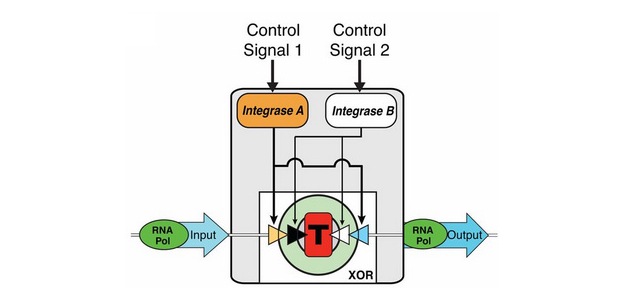 Forget Google Glass and all other human/machine interactions and combinations up to this point. Scientists have, according to a report in New Scientist, created the world’s first biological version of a transistor, opening up the door to a world of biological, living technology. Say hello to our new fleshy Borg futuren.
Forget Google Glass and all other human/machine interactions and combinations up to this point. Scientists have, according to a report in New Scientist, created the world’s first biological version of a transistor, opening up the door to a world of biological, living technology. Say hello to our new fleshy Borg futuren.
Oddly enough, the breakthrough was almost simultaneously create with two teams working completely independent of each other. One team, led by Drew Endy at Stanford University in California, invented “a transistor-like device that controls the movement of an enzyme called RNA polymerase along a strand of DNA, just as electrical transistors control the flow of current through a circuit.” The second team, from Massachusetts Institute of Technology and led by that institution’s Timothy Lu, created a similar device.
Endy’s device differs from the one created by MIT because it not only controls the flow of polymerase – with the biological “transistor” activated via enzymes recognized by logic gates as inputs to start or stop the flow – but also controls the rate of flow, and is able to amplify the flow as necessary.
The Stanford team calls their creation a “transcriptor,” and report that they have already managed to create a full suit of Boolean Integrase Logic gates by combining multiple transcriptors. To put that into a more easily understood context for the layman, the Stanford team have crafted the starting point for a biological computer capable of complicated calculations and computations within living cells.
We’re not there just yet. Extreme Tech points out that we’re still some distance away from that happening. “You also need somewhere to store data… and some way to connect all of the transcriptors and memory together,” it explains, but admits “all of the building blocks of a biological computer are now in place.”
According to Paul Freemont, who works at Imperial College London, these bio-transistors are the first step to building more involved, complicated biological machines. Working from the starting point that transistors are the basis for contemporary electronic devices, it’s only logical to imagine that a cellular transistor could lead to other cellular tech.
Freemont’s suggestion is the creation of “bio sensors” that could monitor water quality cheaply and effectively. “Underpinning all of that will be these foundational components, like in electronics,” he told New Scientist.
Endy, however, is thinking on a somewhat larger scale according to the story; he’s said to be imagining a world filled with “living bridges or buildings constructed by the self-directed growth of their natural materials, controlled by internal biological circuits, or even tiny medical “submarines” with on-board DNA computers navigating the inside of our bodies.”


